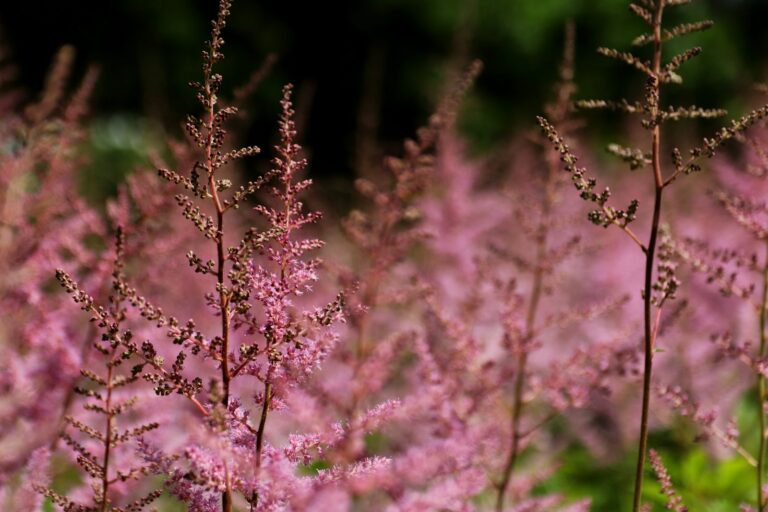Astilbe Watering Guide: Moisture Needs & Irrigation Schedule
Your astilbe receives deep watering twice weekly yet develops brown, crispy foliage while your neighbor’s plants stay vibrant with once-weekly irrigation. The difference stems from root depth and soil moisture retention capabilities. Astilbes develop extensive root systems reaching 8 to 12 inches deep, allowing established plants to access water reserves that shallow-rooted specimens cannot reach[1]. Understanding this growth pattern transforms struggling plants into thriving specimens.
💡Master all aspects of astilbe cultivation with our complete astilbe guide covering variety selection, planting, and ongoing maintenance.
Understanding Astilbe’s Moisture Dependency
Astilbes is one of the most moisture dependent perennials in shade gardens. These plants are not tolerant of extended droughts and need constant moist soil over the course of the growing season. Even deep watering 2 to 3 times weekly is more proficient than regular shallow watering[1]. The root system requires maintaining moisture levels over time, yet waterlogged conditions induce root rot and plant failure[2].
Astilbes cannot tolerate prolonged drought—consistent moisture is the key to thriving plants.
Watering Newly Planted Astilbe
Newly planted astilbes need an entirely different approach than established specimens. Deep water new plants at the beginning of planting, to reduce air pockets and improve soil contact with roots[3]. Keep watering at least twice a week in the first growing season[5]. This regular amount of watering enables roots to settle well and penetrate more deeply into the soil.
💡Proper hydration works hand-in-hand with nutrition—discover the optimal fertilizing schedule to complement your watering routine for maximum bloom production.
By dipping your finger in the soil two to three inches, allow moisture levels to be verified correctly[6]. Soils that aren’t visibly moist from the surface of the soil don’t exactly indicate moisture levels below.
Established Astilbe Watering Schedule
Deep weekly watering for established astilbes in the absence of rain is essential. Each watering should provide 1 to 2 inches of water per session that submerges the root zone fully[2]. Shallow sprinklers promote surface roots that dry out in hot weather. For a great long-term solution deep irrigation trains the roots to grow downwards, creating drought resistance. The soil must be uniformly moist, but not wet, dried out or puddled in any way[6].
Container-Grown Astilbe Watering Needs
Container-grown astilbes are more demanding for the ground stage than those grown in soil. Water potted plants, at least twice a week, in greater amounts if between visits the soil dries. Containers evaporate from all sides and lose moisture rapidly.
Regular moisture assessments of the soil will occur through the insertion of your finger in the potting mixture. Use mild water to fully saturate the soil, instead of quick runoff.
Optimal Watering Timing
The timing of astilbe watering is ideal for morning watering. Morning watering leaves space for foliage to dry and decrease disease[6]. Summer afternoons cause extreme loss of evaporation with no deep penetration of water.
Winter watering is most effective at midday where temperatures are over freezing. Evening or late-day watering can freeze before soil penetration occurs if you are running them during the evening or later in the day.
Drought Tolerance Among Astilbe Varieties
Astilbe species, for example, differ in their resistance to drought. Chinese astilbe strains like Astilbe chinensis are more drought-tolerant compared to Arendsii hybrids[4]. Despite the improvement in resilience, these Chinese species have a need for uniform moist soils for best performance[4].
The usual varieties of astilbe wither quickly when soil turns parched. Foliage browns, curls and can die under water stress[2].
💡Recognize and prevent various types of plant distress by understanding drought stress symptoms and their long-term effects on astilbe health.
Some Chinese varieties can survive weekly watering, in partial shade, while other species need regular irrigation[4].
Drought Tolerance Comparison
| Variety Type | Drought Tolerance | Watering Frequency | Best Conditions |
|---|---|---|---|
| Astilbe chinensis | Moderate | Once per week | Partial shade with good soil |
| Arendsii hybrids | Low | 2-3 times per week | Consistent moisture required |
| Standard varieties | Very low | 2-3 times per week | Never allow to dry out |
Soil Moisture Retention Strategies
Astilbes flourish with humusy organic soils that retain moisture but are not waterlogged[3]. To improve water retention before planting, you can amend planting beds with:
- Compost
- Leaf mold
- Peat moss
These amendments build a sponge for a smooth soil structure to control moisture levels[8]. Even when clay soils show high moisture retention, additional amendments may be required to prevent waterlogging.
The Critical Role of Mulch
Apply mulch, this reduces watering needs dramatically. For astilbe plants, apply a 2 to 3 inch layer of organic mulch each spring[1].
Mulch helps provide moisture in the soil, regulates soil temperature and can also add organic material while it decomposes. This is most effective, or at least with some, of the arborist mulch, shredded bark or compost. Avoid stacking mulch over crowns to avoid crown rot. As the material breaks down, ensure that mulch is replaced annually.
💡Strategic mulching for moisture retention can reduce watering frequency by 50% while improving soil quality and temperature regulation.
Pro tip: Maintain mulch layers annually to conserve soil moisture and reduce watering frequency by up to 50%.
Recognizing Water Stress Symptoms
Identifying water stress symptoms will also enable intervention. The wilting signs of leaves indicate that on-demand water is needed even if soil is moist on the surface of the ground[6]. Brown edges of the leaf indicate chronic underwatering or excessive sun exposure.
Drooping plants may return to their original state overnight if there is adequate soil moisture from afternoon heat. Yellowing leaves combined with mushy stems indicate overwatering and root rot[6]. Sensitive dry leaves show heavy water stress or sun scorch.
💡Diagnose and treat foliage issues with our comprehensive guide to water-related leaf issues including browning, yellowing, and wilting patterns.
Common Water Stress Symptoms
| Symptom | Likely Cause | Immediate Action |
|---|---|---|
| Wilting leaves | Insufficient water | Water deeply immediately |
| Brown leaf edges | Chronic underwatering or sun exposure | Increase watering frequency, provide shade |
| Yellowing leaves + mushy stems | Overwatering, root rot | Reduce watering, improve drainage |
| Crispy, dry leaves | Severe water stress or sun scorch | Deep watering, relocate to shadier spot |
| Afternoon drooping that recovers overnight | Temporary heat stress | Continue current schedule, adequate moisture present |
Irrigation Methods and Efficiency
Water delivery efficiency is affected by irrigation. Soaker watering devices and drip irrigation systems send water directly to root zones with low evaporation loss. Water at the base of plants instead of overhead to decrease disease risk and improve usage efficiency[7].
Overhead watering wets leaves unnecessarily and wastes water through evaporation. The hose provides perfect control by hand, however, it is time consuming and requires much more attention.
Supplementing Natural Rainfall
Rainfall is natural irrigation but often doesn’t satisfy the astilbe needs entirely. Measure rainfall levels using a rain gauge that sits in your garden. Contribute more naturally occurring precipitation if weekly totals don’t exceed 1 inch.
Thunderstorms in summer that deliver large quantities of rain in short bursts run off water and do not percolate very deeply into the ground. Assess soil moisture following storms to see if additional watering is still needed.
Seasonal Watering Adjustments
Seasonal changes help streamline watering. Plants need constant moisture to establish themselves in spring as they enter maturity as they break dormancy and grow new growth[8]. Heat in the summer makes evaporation rates rise and plant water needs increase.
💡Navigate the challenging hot months with targeted summer watering needs strategies including timing adjustments and frequency increases.
More water during warm periods and prolonged dry spells. Fall watering is a means to keeping plants healthy as foliage gets ready for dormancy. Reduce the frequency of watering as temperatures cool and rainfall generally increases. Winter watering doesn’t work in a plant once it has become fully dormant.
Drainage Quality Assessment
Watering volume and quality are as important as the quantity you manage watering. Well-drained soils are good drainage which keeps adequate moisture in soil away from roots but with proper moisture retention allowing any excess water to move away from roots while retaining adequate moisture[3].
Poor irrigation can cause waterlogging that suffocates roots and leads to disease. Test the drainage by digging a hole 12 inches deep and filling it with water and see how quickly water will run off your soil. Water should drain inside a few hours. Slow drains are considered to be due to soil replacement or raised bed building.
Sun Exposure and Water Requirements
In sun exposure, water needs become an issue. Under full sun the sun requires more frequent watering than its shade-planted counterparts for those whose plants are growing. The shade-planted specimens have more limited ventilation sources.
Hot afternoons will make it increasingly more likely for water to accumulate because of transpiration and evaporation. Morning sun plants with afternoon shade require moderate watering. When full shade falls, soil moisture retention of the crop is greatest, but requires regular irrigation when crops are dry.
Water Quality Considerations
Water quality affects plant vigor in long time. High level of chlorine in municipal water if used regularly may stress astilbes. Let tap water drain into your land overnight before watering to allow the chlorine to dissipate.
Rainwater collection offers perfect irrigation with a controlled pH and no chemicals included. Well water contains lots of minerals that affect soil pH with time.
Recovery from Drought Stress
Astilbes have an outstanding capacity for regeneration when properly protected following drought stress. Cut stressed plants back to ground level, water deeply and apply a new mulch[2]. New growth often appears, within weeks, if crowns survive.
This recovery exemplifies the sustainability of the already established root systems when moisture returns. The recovery attempts are never going to be ideal, as prevention is always better.
Consistency: The Key to Success
Maintaining moisture consistently is the best solution. Astilbes bloom at a very high rate, have good enough foliage in the summer when the soil moisture is optimal, and sprout slowly[1]. Irregular watering results in stress cycles that prevent flowering, slow development and damage plants over time.
Set a watering schedule not on a calendar, but on soil tests. Use varying frequency according to weather, soil kind and the reaction of the plants.
Key Sources:
[1] Growing and Caring For Astilbe Plants | Nature Hills Nursery
[2] How to Grow Astilbe | American Meadows
[3] Plant & Care for Astilbe | White Flower Farm
[4] Astilbe chinensis ‘Visions’ | Missouri Botanical Garden
[5] Astilbe Planting and Growing Tips | Breck’s
[6] Watering Astilbe | Plant Addicts
[7] Astilbe Growing Tips and Benefits | Spring Hill Nursery
[8] How to Grow Astilbes | The Old Farmer’s Almanac
Lily Morgan is a home gardener. She grows houseplants and designs small-space gardens. She shares what she learns from experience. Lily offers simple, practical tips for plant lovers. Her goal is to help others garden with confidence. She wants to help them grow, one leaf at a time.


